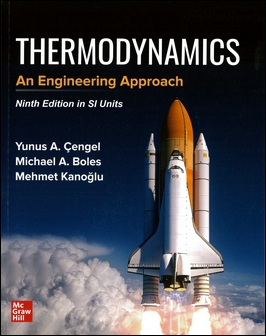書籍分類

Thermodynamics: An Engineering Approach 9/e (SI Units)
作者:Yunus Cengel, Michael A. Boles, Mehmet Kanoglu
原價:NT$ 1,350
ISBN:9789813157873
版次:9
年份:2020
出版商:McGraw-Hill
頁數/規格:964頁/平裝彩色
參考網頁:Thermodynamics: An Engineering Approach 9/e (SI Units)
版次:9
年份:2020
出版商:McGraw-Hill
頁數/規格:964頁/平裝彩色
參考網頁:Thermodynamics: An Engineering Approach 9/e (SI Units)
內容介紹 本書特色 目錄
- (E-Book) Thermodynamics: An Engineering Approach 9/e (SI Units)
Description
Distinguished as a best seller, the title Thermodynamics: An Engineering Approach is taking another step towards excellence with this revised edition. Through its careful explanations of concepts and use of numerous practical examples and figures, this book aims to bridge the gap between knowledge and application.
About the Cover
The launch of a space shuttle occurs with the help of a rocket. Operation of a rocket engine is an exemplary application of thermodynamics, which involves a sequence of thermodynamic processes. The chemical energy that s stored in the fuel of the rocket engine is first converted into thermal energy and then kinetic energy. As the rocket climbs higher into the atmosphere, some of that kinetic energy get stored as gravitational potential energy. In addition, the combustion products (gases) accelerate through a converging-diverging nozzle to supersonic speeds in accordance with the first and second laws of thermodynamics. This provides the net positive thrust against the air drag, which propels the rocket in the opposite direction.
分類位置:
理工 > 機械工程 > 熱力學


